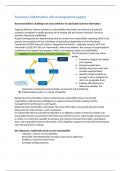Summary
Summary of the papers of information risk management
- Course
- Institution
This is an English summary of all the seven papers which are mandatory to study for the exam of information risk management. Information risk management is one of the courses of the master accounting & control at VU Amsterdam.
[Show more]



